💪 Support independent web, support us:
If you have seen the landmarks in Europe, you’d know there are quite a few of them are here in Lithuania.
Across the green fields and along the curves of the amber shores, Lithuania boasts a treasure trove of architectural wonders.
From the Gothic spires of Vilnius Cathedral to the red-brick turrets of Trakai Castle, each landmark stands tall as a proud tribute to the nation’s rich cultural heritage.
1. Vilnius Old Town
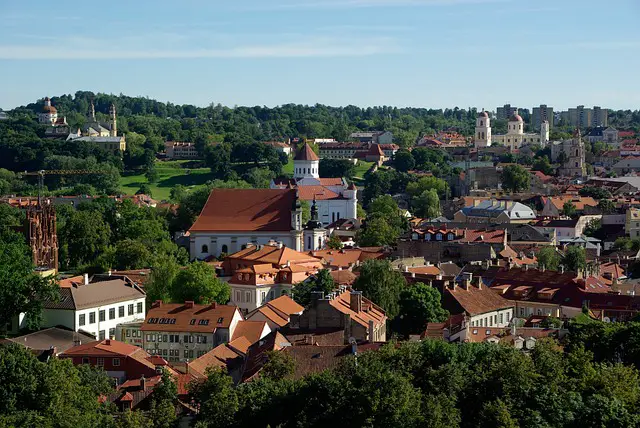
Vilnius Old Town is the historic center of Vilnius, the capital of Lithuania, and is a UNESCO World Heritage Site.
What to see or do: – Visit the Cathedral Square, the heart of the city and the location of Vilnius Cathedral.
Don’t miss: – The Church of St. Anne, one of the most beautiful and recognizable buildings in Vilnius, known for its intricate Gothic architecture.
Insider travel tips: – Visit Vilnius Old Town in the summer, when the weather is pleasant and there are outdoor events and festivals.
2. Trakai Island Castle
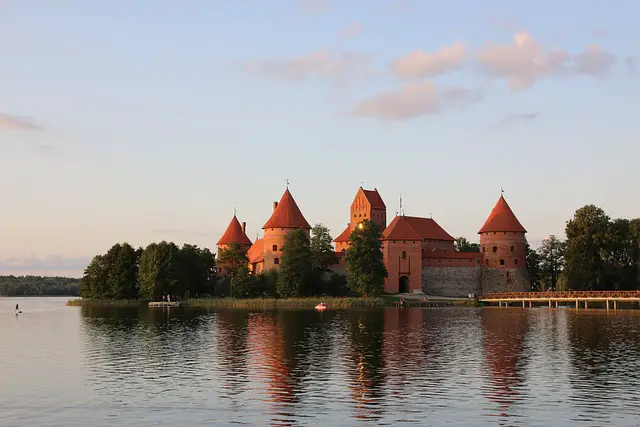
A stunning medieval fortress located on an island in the middle of Lake Galvė in Lithuania.
What to see or do: Take a tour of the castle’s grand halls, chapels, and towers. Marvel at the intricate brickwork and Gothic architecture.
Enjoy the beautiful panoramic views of the surrounding lake and forests.
Don’t miss: The museum showcasing the history of Trakai Island Castle and its importance to Lithuanian culture and heritage. Also, make sure to walk along the castle walls and visit the small Church of the Holy Virgin Mary.
Insider travel tips: Arrive early to avoid the crowds and enjoy the peacefulness of the lake surroundings. Consider taking a boat tour of the lake to take in even more of the castle and natural beauty.
Additionally, if you’re a history buff, try to visit during one of the castle’s many historical reenactments or festivals for an even more immersive experience.
3. Hill of Crosses
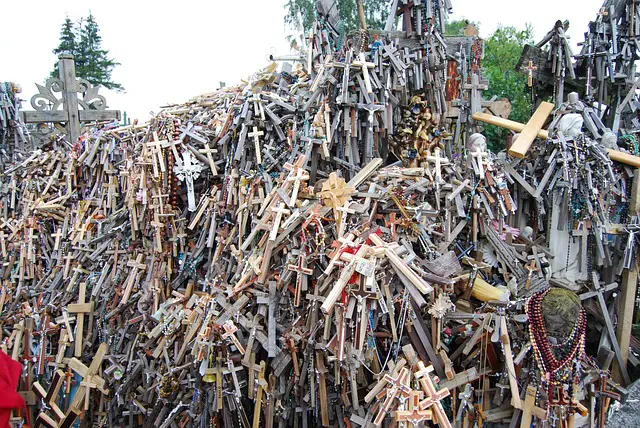
A site of pilgrimage and remembrance featuring over 200,000 crosses on a hill in Lithuania.
What to see or do: Marvel at the seemingly endless array of crosses, each symbolizing a prayer, devotion, or memorial. Take a moment to reflect and appreciate the peaceful atmosphere and picturesque surroundings.
Don’t miss: The incredible views from the hilltop, especially at sunset.
Also, keep an eye out for some unique cross designs, including a giant metal crucifix and a cross made entirely of bells.
Insider travel tips: Visit during the off-season to avoid crowds and have a more intimate experience.
Bring a small cross or other item to leave on the hill as a symbol of your own devotion or remembrance.
Dress for the weather, as it can be windy and cold on the hilltop.
4. Klaipėda Old Town

Klaipėda Old Town is a picturesque area in the heart of the city with narrow streets and colorful half-timbered buildings.
What to see or do: Take a stroll through this charming area and admire the historic architecture. Stop by Theatre Square, Annchen von Tharau Fountain, and the old post office building.
There are also several museums and galleries to visit, including the Lithuanian Sea Museum.
Don’t miss: Make sure to stop by the sculpture of a quirky cat named Chochol, said to bring good luck to visitors. Also, don’t miss the Amber Museum, showcasing the history and importance of amber in the region.
Insider travel tips: Make sure to wear comfortable shoes as the streets can be uneven and hilly. The best time to explore the area is in the morning, when it’s quieter and less crowded.
Grab a coffee or a bite to eat at one of the many cafes or restaurants in the area.
5. Gediminas’ Tower
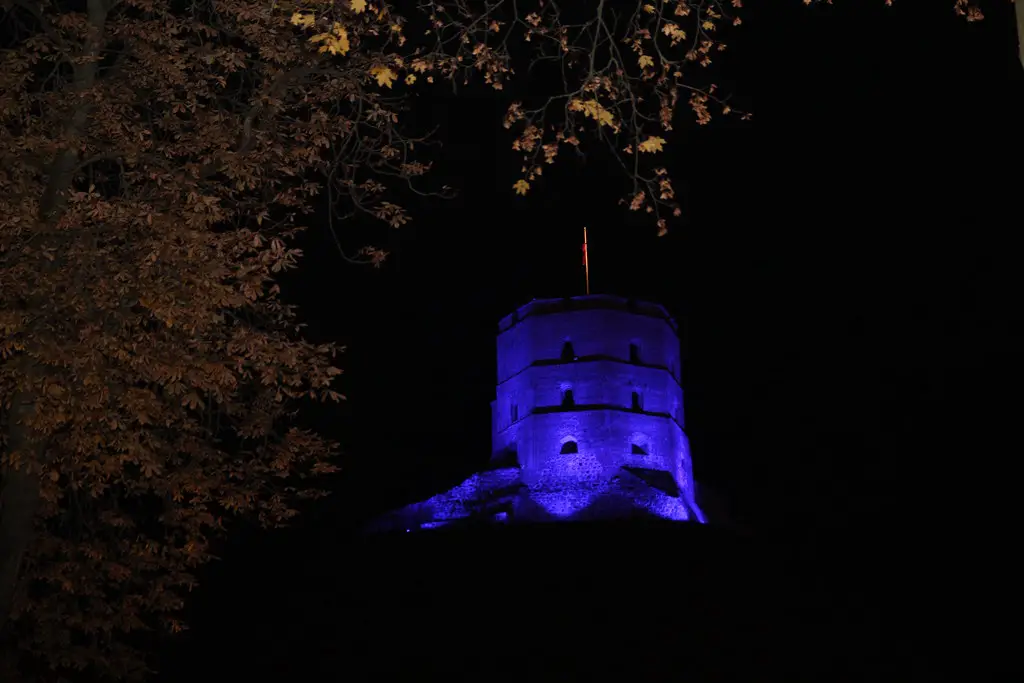
A historic tower located in Vilnius, Lithuania that served as a part of the Upper Castle complex.
What to see or do: Visitors can climb to the top of the tower to enjoy stunning views of Vilnius. The tower also houses an exhibition about the history of the castle.
Don’t miss: The panoramic views of the city from the tower’s observation deck. Also, make sure to take a walk around the castle complex to see the remaining structures and historical artifacts.
Insider travel tips: Try to visit the tower in the morning or evening to avoid crowds. Wear comfortable shoes as there are steep steps to climb.
Lastly, make time to explore the old town of Vilnius, which is located nearby and is full of charming streets and historical sites.
6. Kaunas Castle
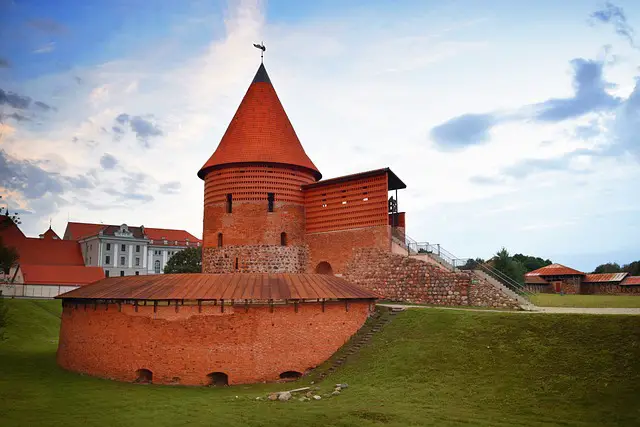
Kaunas Castle is a medieval castle located in the city of Kaunas, Lithuania.
What to see or do: Visitors can explore the castle’s towers, walls, and passages, and learn about its rich history at the museum inside.
Don’t miss: Be sure to check out the castle’s ancient crypt and impressive courtyard, where events and concerts are often held during the summertime.
Insider travel tips: Get the most out of your visit by taking a guided tour and learning about the castle’s significant role in the nation’s history.
Check the museum’s website for special events and seasonal information.
7. Curonian Spit National Park
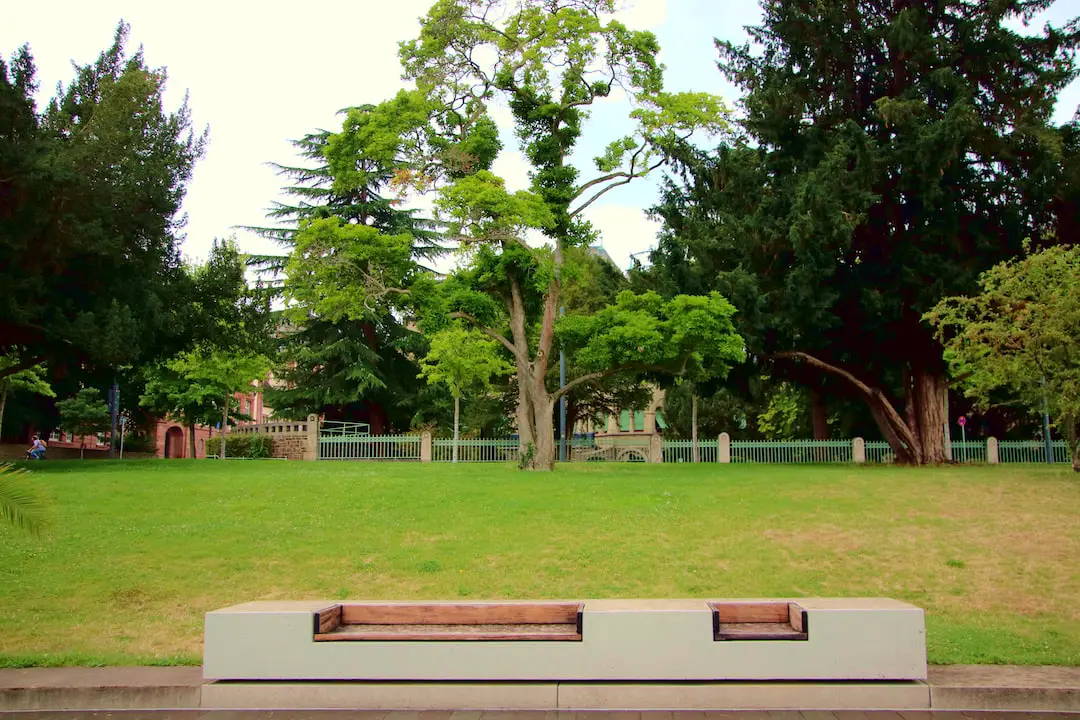
The Curonian Spit National Park is a natural reserve located in Lithuania and Russia, stretching along the coast of the Baltic Sea.
It features sand dunes, forests, and wetlands, all of which are home to a wide range of flora and fauna.
What to see or do: Visitors can explore the park by foot, bike, or even on horseback. Take a stroll through the Parnidis Dune, which offers stunning views of the nearby lagoon and sea.
The Dancing Forest, a unique place where trees grow in oddly twisted shapes, is also worth a visit.
Don’t miss: The UNESCO World Heritage Site of the Hill of Witches, where you can see over 80 wooden sculptures depicting Lithuanian folk tales, and learn about local mythology.
The Nagliai Nature Reserve is another must-see spot, filled with rare and fascinating plant species.
Insider travel tips: – The best time to visit the park is during the spring or autumn, when the crowds are fewer, and the temperatures are mild.
8. Kernavė Archaeological Site

A UNESCO World Heritage Site located in Lithuania that showcases the remains of an ancient settlement dating back to the 5th millennium BC.
What to see or do: Explore the site’s five hillforts, ancient burial grounds, and reconstructed homes from various eras of Lithuanian history. Take in the scenic views of the surrounding landscape, including the winding Neris River.
Don’t miss: The Kernavė Summer Archaeological Festival, which takes place annually in July and features traditional crafts, reenactments, and live music performances.
Insider travel tips: Wear comfortable walking shoes and bring a camera to capture the stunning views. Take advantage of the on-site visitor center for a more immersive historical experience.
Plan your visit during the summer months for the most activities and events.
9. Pažaislis Monastery

Pažaislis Monastery is a baroque-style monastery located near Kaunas, Lithuania. It was founded in the 17th century and is known for its stunning architecture and beautiful natural surroundings.
What to see or do: Visitors can take in the grandeur of the monastery’s architecture, including its impressive domed basilica. The grounds are also home to a picturesque lake and lovely gardens.
Don’t miss: Be sure to check out the monastery’s incredible frescoes and impressive baroque sculptures. The onsite museum also offers a fascinating look into the history of the monastery and the region.
Insider travel tips: Consider visiting the monastery during one of its many musical festivals, which take place throughout the summer and feature both sacred and secular music performances.
Additionally, while the monastery can be accessed by car, visitors can also take a scenic boat ride across the lake to the site.
10. Frank Zappa Memorial
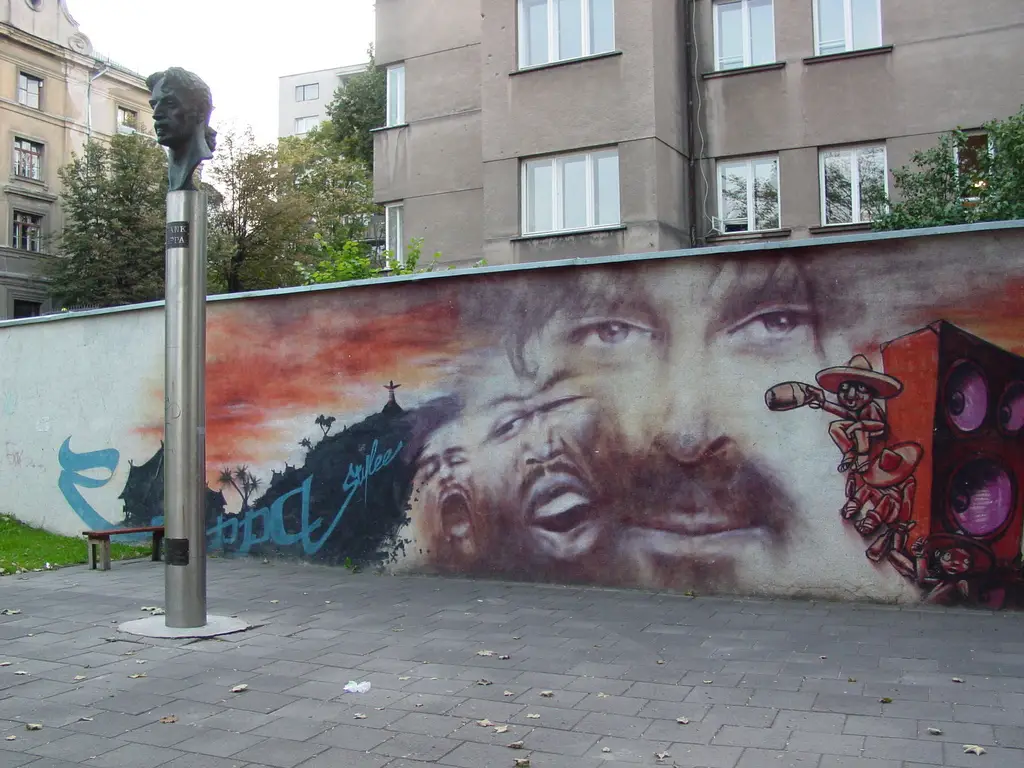
The Frank Zappa Memorial is a tribute to the legendary musician and composer, Frank Zappa.
What to see or do: The memorial, located in Baltimore, Maryland, features a bronze bust of Zappa and a small park area with benches for visitors to relax and reflect.
Don’t miss: Don’t miss the opportunity to pay your respects to one of the most influential musicians of the 20th century.
Insider travel tips: The memorial is located in a quiet residential neighborhood, so respect the peace and privacy of local residents when visiting.
11. Pilies Street
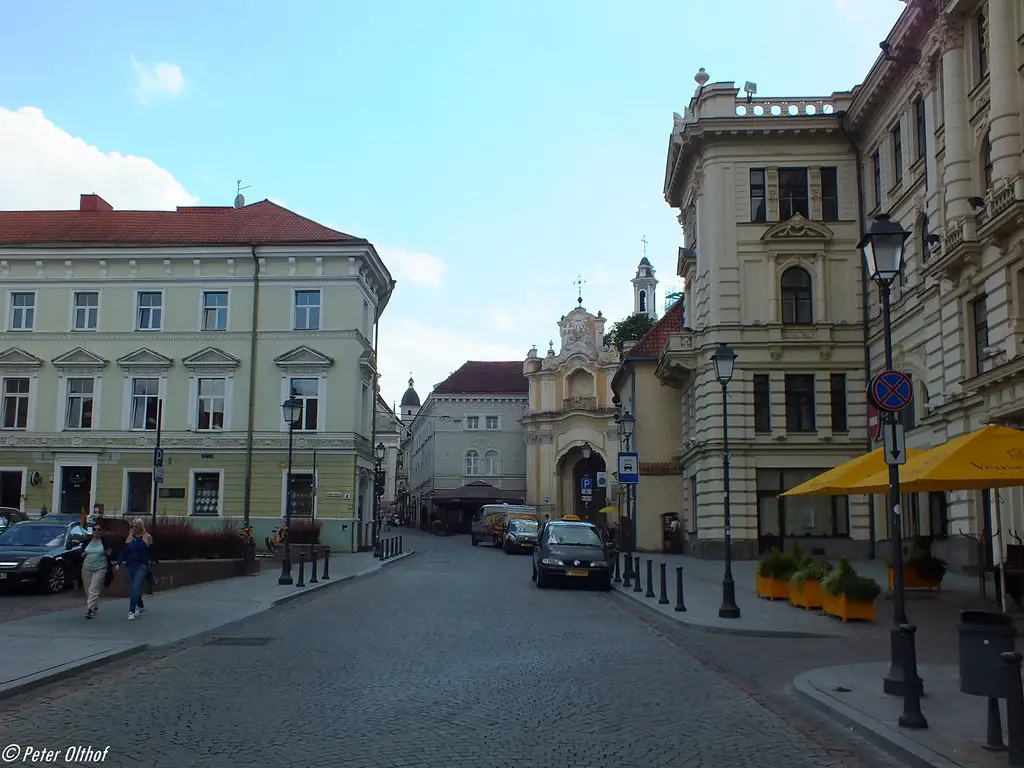
Picturesque cobbled street in the heart of Vilnius Old Town.
What to see or do: Stroll along the street, admire the colorful buildings, browse the souvenir shops, stop at a cozy café or restaurant.
Don’t miss: The stunning St. Anne’s Church, the Gothic House, the Palace of the Grand Dukes of Lithuania.
Insider travel tips: Visit early in the morning or late at night to avoid crowds, wear comfortable shoes as the street is cobblestoned, and check out the hidden courtyards for some lovely surprises.
12. St
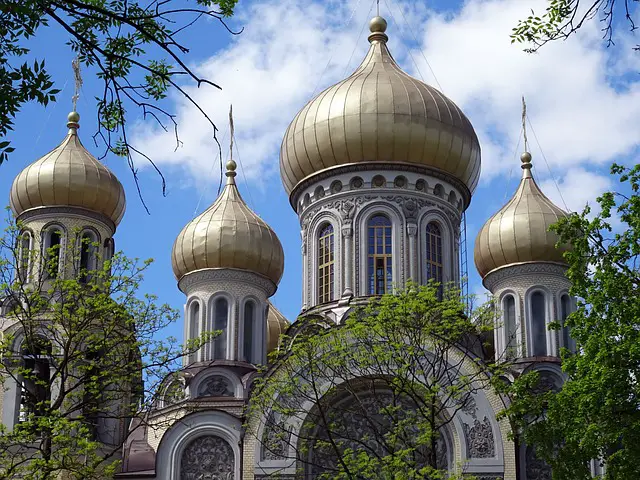
St.
What to see or do:
Don’t miss: The Church of the Savior on Spilled Blood, St.
Insider travel tips: Try traditional Russian cuisine at restaurant Palkin, avoid visiting the Hermitage Museum on Tuesdays (when it is closed), be prepared for crowds during the peak tourist season from May to September, learn basic Russian phrases to enhance your travel experience.
13. Island Castle

Island Castle is a stunning castle that sits atop a small island and boasts breathtaking views of the surrounding landscape.
What to see or do: Tourists can take a boat ride to the castle and explore its various rooms, including the medieval great hall, the elegant ballroom, and the cozy bedchambers.
Visitors can also stroll through the castle’s peaceful gardens, admire the intricate architecture, and take in the incredible views from the top of the tower.
Don’t miss: The castle’s impressive collection of artwork, tapestries, and artifacts, which offer a glimpse into the region’s rich cultural history. Also, be sure to pause and enjoy the peaceful views of the surrounding countryside from the castle’s tranquil gardens.
Insider travel tips: Be sure to arrive early in the day to avoid the crowds and get the best views of the castle and the surrounding landscape.
Also, consider taking a guided tour to learn more about the castle’s rich history and unique architecture. Finally, don’t forget to bring a camera with you, as the photo opportunities at Island Castle are simply breathtaking.
14. Rumsiskes Open Air Museum
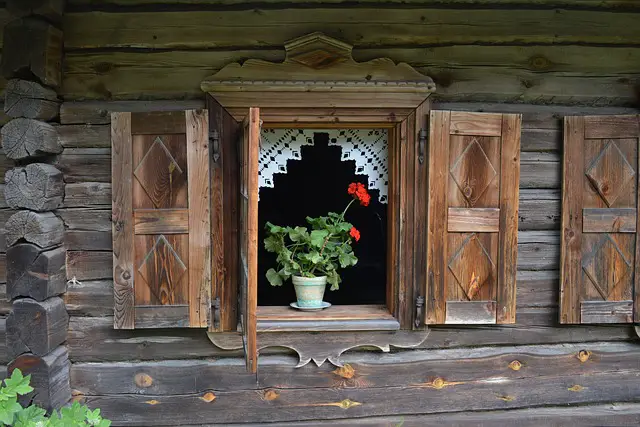
Rumsiskes Open Air Museum is a fascinating open-air museum spread across 175 hectares in Lithuania, exhibiting the country’s rural architecture and way of life.
What to see or do: Visitors can stroll through the five different ethnic regions, including Sudovian, Aukstaitian, Dzukian, Zemaitukian, and Lithuania Minor, each boasting traditional houses and other structures.
Learn about the daily routine and practices of these different ethnic groups through hands-on exhibitions and displays.
Don’t miss: Don’t forget to take the guided tour, which offers insightful information on the history, culture, and traditions of each region. Don’t miss the annual summer festival, which features traditional folk dances, music, and performances.
Insider travel tips: Visit during the weekdays to avoid the weekend crowd. Wear comfortable shoes as the museum is quite vast, and some of the areas are rugged and uneven.
Bring cash as credit cards are not always accepted. Consider packing a picnic to enjoy the picturesque scenery in one of the park’s many picnic areas.
15. Three Crosses Hill
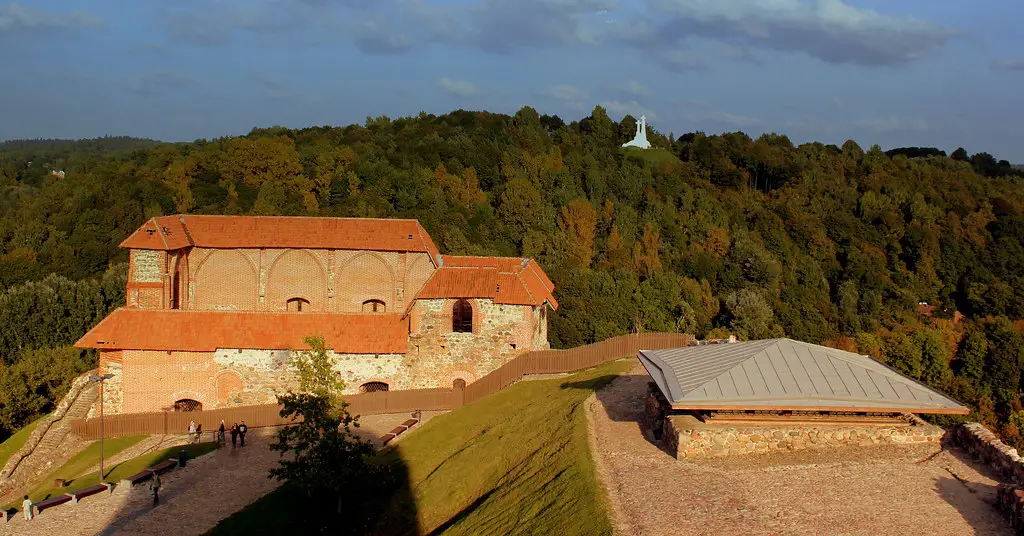
A hill located in Vilnius, Lithuania, known for its historical significance and picturesque views of the city.
What to see or do: Visitors can climb to the top of the hill to see the three large wooden crosses that were erected in the 17th century as a symbol of the city’s religious devotion.
The hill is also a popular spot for tourists to take photos and enjoy the panoramic views of Vilnius.
Don’t miss: The sunset from Three Crosses Hill is particularly stunning, offering a perfect photo opportunity. Also, the hill is surrounded by a beautiful forest with hiking trails for those looking to explore the area further.
Insider travel tips: Be sure to wear comfortable shoes as the climb to the top of the hill can be steep.
Additionally, while the area is generally safe, it is recommended to visit during daylight hours and to keep belongings secure to avoid any possible theft.
16. Šiauliai Ausros Museum

Šiauliai Ausros Museum is a history museum located in the city of Šiauliai in Lithuania.
What to see or do: Visitors can explore the exhibits that showcase the history and culture of the region, including collections related to archaeology, ethnography, and the countercultural movement.
Don’t miss: One of the highlights of the museum is the room dedicated to the artist and musician Pakalnė, which features a reconstruction of his studio.
The museum’s exhibit on the Lithuanian freedom fighter Jurgis Šaulys is also worth checking out.
Insider travel tips: Visitors can rent an audio guide to learn more about the exhibits and the history behind them.
17. KGB Museum
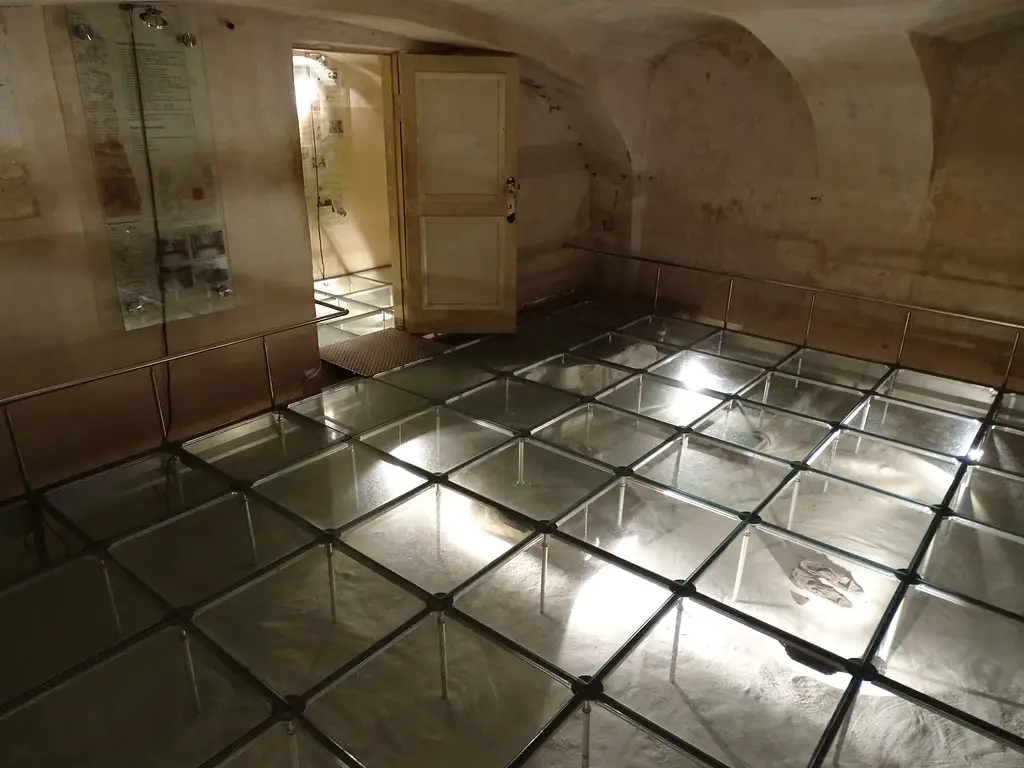
The KGB Museum, also known as the Museum of Genocide Victims, is a former KGB headquarters that has been turned into a museum dedicated to preserving the history of Soviet oppression in Lithuania.
What to see or do: The museum features exhibits showcasing the brutal tactics utilized by the KGB to enforce Soviet rule in Lithuania, including torture chambers, prison cells, and interrogation rooms.
Visitors can also view personal items belonging to victims of the regime, such as photographs, letters and belongings.
Don’t miss: Don’t miss the opportunity to step inside a real KGB cell and experience the oppressive conditions firsthand. The memorial room dedicated to the victims who lost their lives to Soviet persecution is also a must-see.
Insider travel tips: – The museum can be emotionally intense, so be prepared for a somber experience.
18. Presidential Palace of Lithuania
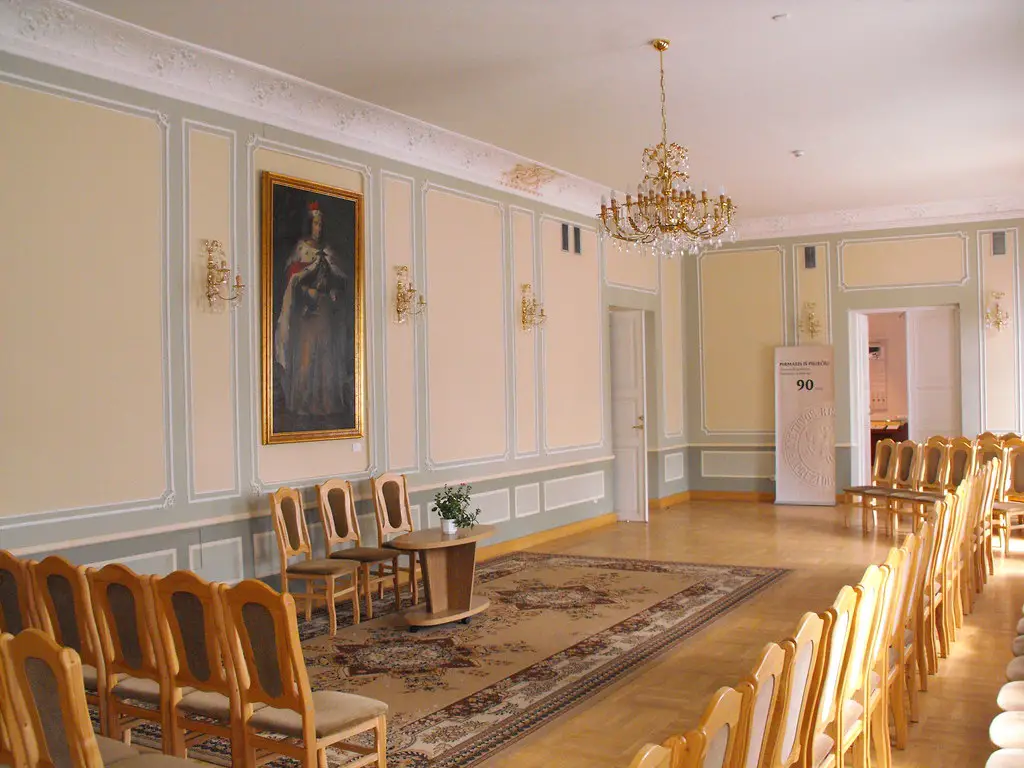
The Presidential Palace of Lithuania serves as the official residence of the President of Lithuania in the country’s capital city, Vilnius.
What to see or do: Visitors can take a guided tour of the palace to see its opulent interior, including the grand staircase, ceremonial halls, and the President’s office.
Don’t miss: Make sure to check out the changing of the guard ceremony, which takes place in front of the palace every hour on the hour.
Insider travel tips: It’s recommended to book your tour in advance as spaces fill up quickly. Photography is not permitted inside the palace, so make sure to leave your cameras at home.
19. City Hall
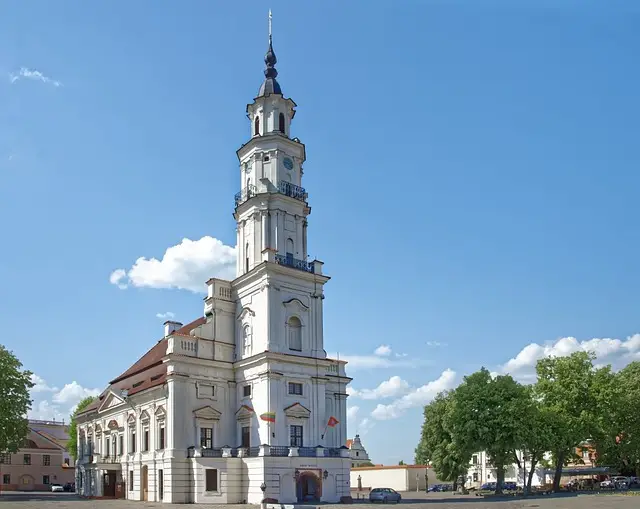
A historic government building located in the heart of a city.
What to see or do: Visitors can take a guided tour of the building’s interior to learn about its architecture and history. Some City Halls also have public spaces like plazas and gardens, used for events like farmers’ markets or concerts.
Don’t miss: The stunning architecture and grandeur of the building’s interior, as well as the often-impressive views from the surrounding plaza or observation decks.
Insider travel tips: Check ahead for any events or activities taking place at the City Hall during your visit, as well as any potential entry fees or tour schedules.
It’s also possible to attend public meetings or events held at the City Hall, which can give you a unique glimpse into the city’s local politics.
20. St

St.
What to see or do: Visit the Hermitage Museum, see the Church of the Savior on Spilled Blood, take a boat tour along the canals, visit the Peterhof Palace and Gardens, see a ballet or opera performance at the Mariinsky Theatre.
Don’t miss: The White Nights in summer, the spectacular Hermitage Museum collection, the stunning mosaics and artwork at the Church of the Savior on Spilled Blood, the fountains and grandeur of Peterhof Palace and Gardens.
Insider travel tips: Buy tickets in advance for popular attractions to avoid long lines. Consider visiting in the summer during the White Nights festival for extended daylight hours and cultural events.
Take a guided tour to learn more about the history and architecture of the city. Try traditional Russian cuisine at local restaurants for an authentic dining experience.
21. Vytautas the Great Monument
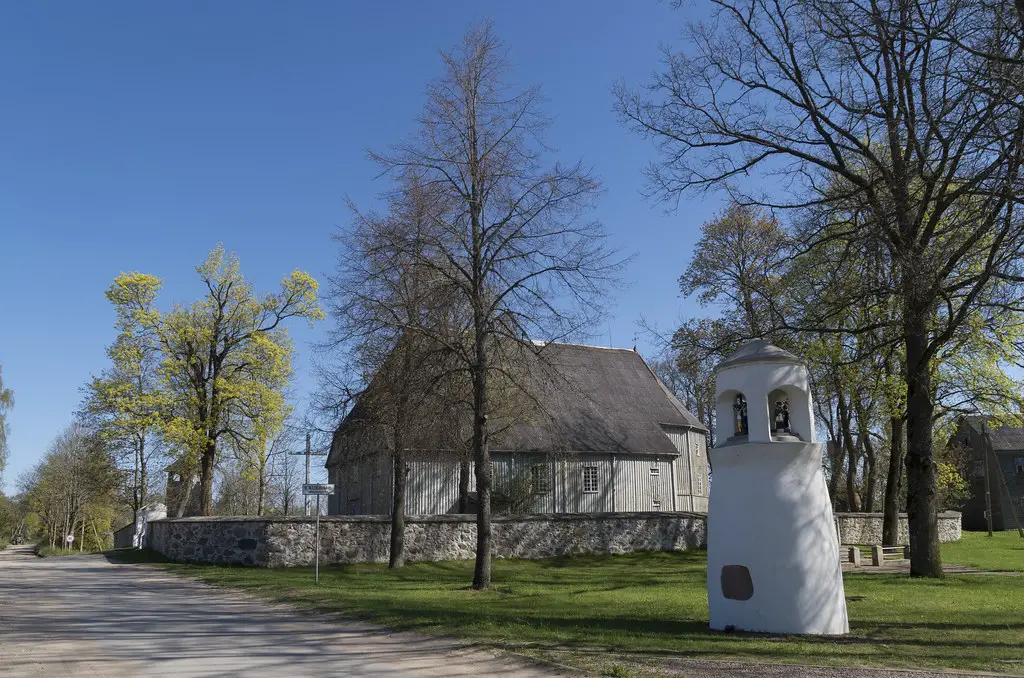
The Vytautas the Great Monument is a bronze equestrian statue located in the historic city center of Kaunas, Lithuania.
What to see or do: The monument depicts Grand Duke Vytautas, who was one of the most influential rulers in Lithuanian history. The statue stands tall at the center of a square and is surrounded by beautiful architecture and bustling streets.
Don’t miss: Visitors should explore the surrounding area and take a stroll through the nearby Kaunas Castle, which dates back to the 14th century and offers breathtaking views of the city.
Insider travel tips: It’s best to visit the monument during weekdays, as it can get crowded during weekends.
Also, don’t forget to take a closer look at the intricate details of the statue, which features the dukes’ armor, horse, and other significant historical elements.
22. Ninth Fort Museum
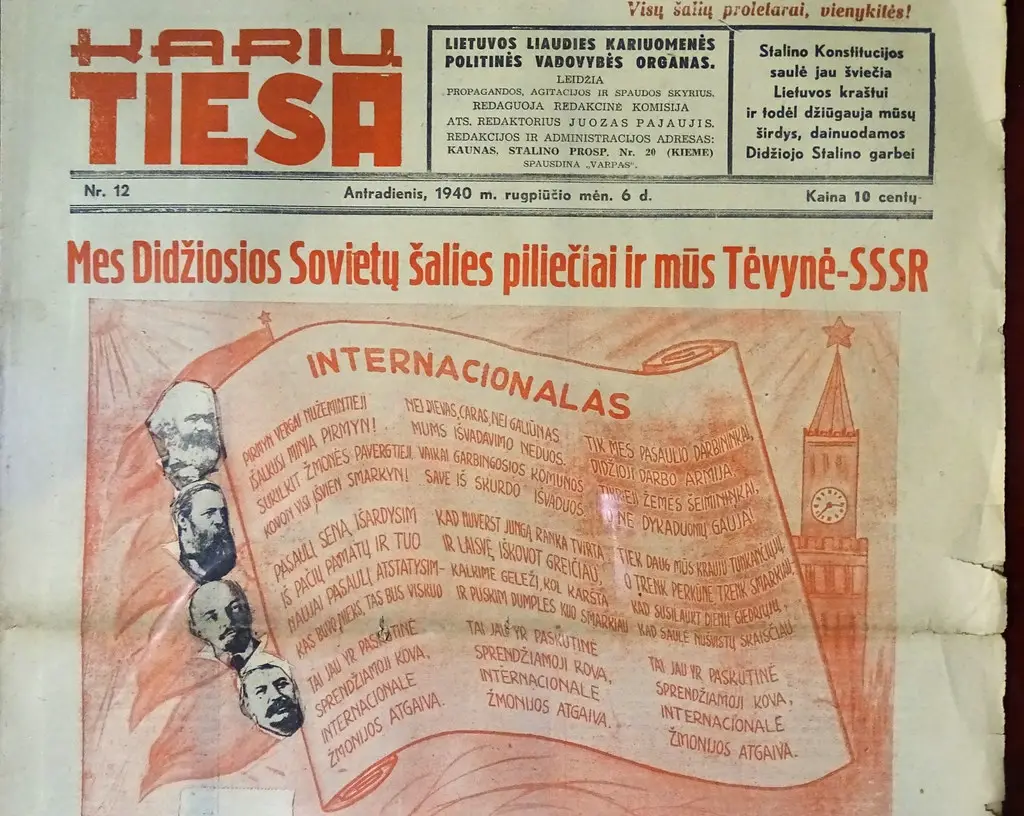
A historical museum located in the Ninth Fort of Kaunas, Lithuania.
What to see or do: Explore the exhibitions that showcase the history of Lithuania during World War II and Soviet occupation.
Don’t miss: The reconstructed prison cells and the memorial to the victims of the mass execution that took place at the Ninth Fort.
Insider travel tips: Plan to spend at least a few hours at the museum to fully appreciate the history and significance of the site.
Additionally, be prepared for an emotional experience as the exhibitions can be quite intense.
23. Cathedral Square
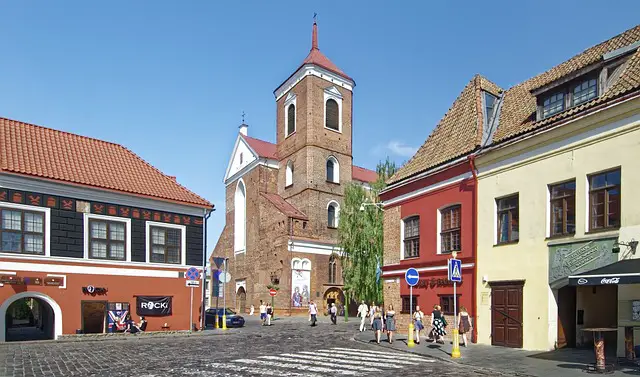
Cathedral Square is a historic public square located in the heart of Christchurch, New Zealand.
What to see or do: – Admire the stunning architecture of the Christchurch Cathedral, which was severely damaged during the 2011 earthquake.
Don’t miss: – The Christchurch Tram, which stops at Cathedral Square and offers a great way to explore the city.
Insider travel tips: – If you’re visiting in the summer, make sure to bring sunscreen and a hat as the sun can be strong.
24. Kaunas City Hall
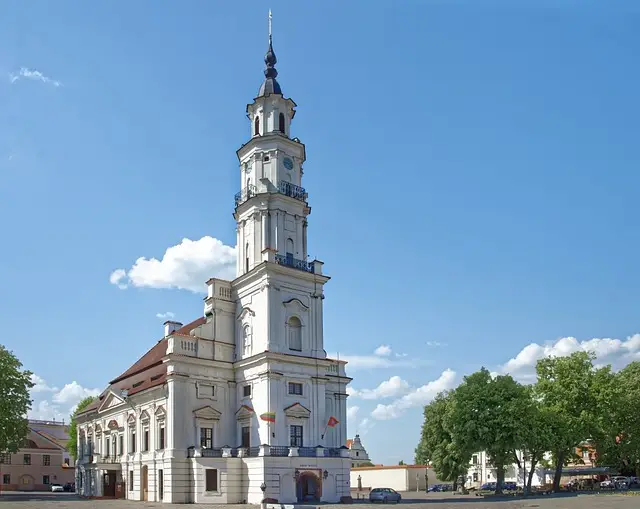
Historic city hall building in the heart of Kaunas, Lithuania.
What to see or do: Admire the beautiful architecture of the Neo-Baroque style building, take a guided tour to learn about the history and significance of the building and the city.
Don’t miss: The view from the top of the tower, which offers a breathtaking panorama of the city.
Insider travel tips: Visit during the annual Pažaislis Music Festival, when the City Hall serves as one of the main concert venues. Make sure to book your tour in advance to ensure availability.
25. Molėtai Astronomical Observatory

Molėtai Astronomical Observatory is a modern and cutting-edge scientific research center located in Molėtai, Lithuania.
What to see or do: Visitors can explore the fascinating world of astronomy by taking part in guided tours, stargazing events, and attending lectures.
The observatory has a range of telescopes and scientific instruments that can be observed, and visitors can learn about the latest discoveries in astrophysics and space science.
Don’t miss: The highlight of the observatory is its state-of-the-art 1.65 m Ritchey–Chrétien telescope, which is one of the largest in Europe.
Visitors can witness the incredible power of this telescope during evening tours when it is used to explore the night skies.
Insider travel tips: – Visitors should bring warm clothing as the observatory can get chilly at night.
26. Vingis Park
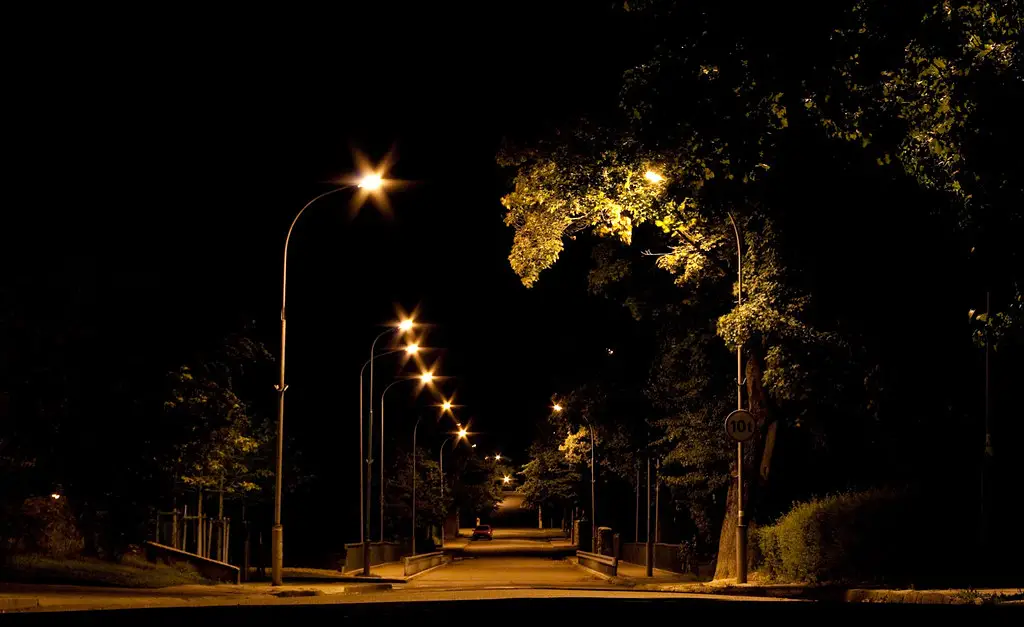
A large park in Vilnius, Lithuania, covering around 160 hectares of green space.
What to see or do: Visitors can enjoy jogging and cycling paths, have a picnic, visit the playground, or attend concerts and events in the open-air amphitheater.
Don’t miss: The serene Vingis Lake, located in the park’s northeast corner, is a perfect spot for relaxation. Visitors can also find the Vingis Stadium and the Lithuanian National Martynas Mažvydas Library nearby.
Insider travel tips: Vingis Park is best to visit during the summer months when it hosts many festivals and events. It can be easily accessed by bus, trolleybus or taxi.
27. St

St.
What to see or do:
Don’t miss: Walking along Nevsky Prospect, trying borscht and other traditional Russian dishes, visiting St.
Insider travel tips: Purchase tickets for popular attractions in advance to avoid long lines, learn a few basic Russian phrases to help with navigation and communication, be aware of pickpockets especially in crowded areas, dress warmly in winter as temperatures can drop significantly.
28. Verkiai Palace and Park
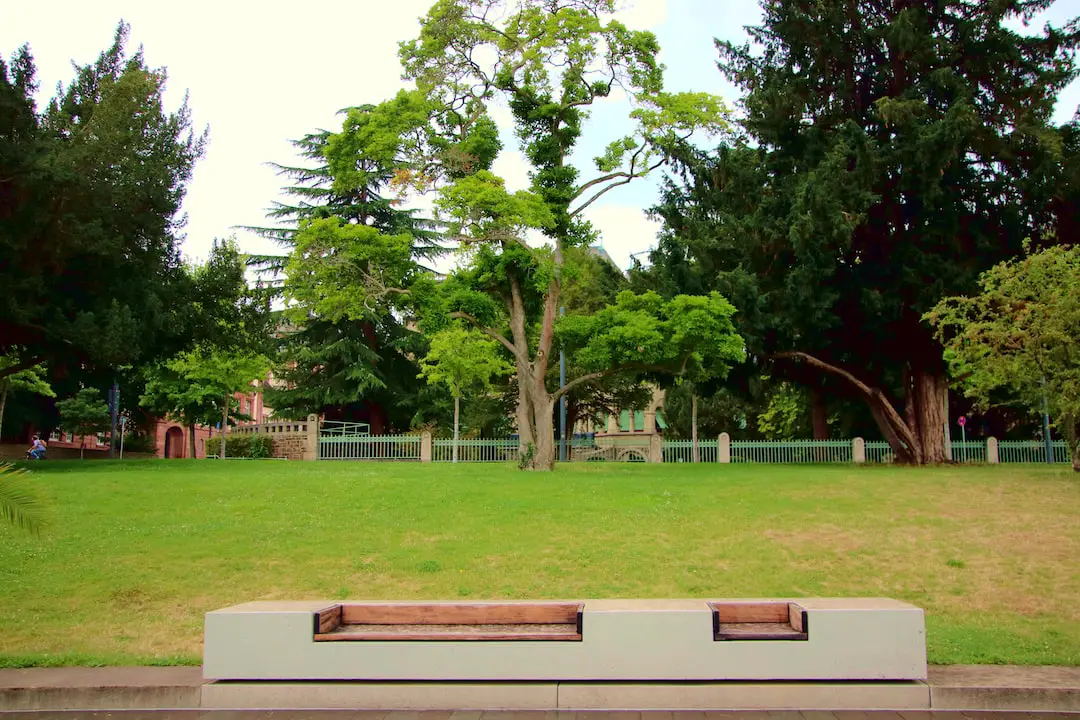
Verkiai Palace is a grand 18th-century Baroque-style mansion located in Verkiai Regional Park, just a few kilometers north of Vilnius city center.
The palace was built for the Chancellor of the Grand Duchy of Lithuania, Jurgis Mikšas Radvila, and was later used as a summer residence for the Lithuanian president.
What to see or do: Take a tour of the palace and admire the stunning Baroque architecture and impressive interior design features, including intricate stucco details, frescoes, chandeliers, and grand staircases.
Relax and enjoy a stroll through Verkiai Regional Park, with its picturesque ponds, peaceful forests, and rolling hills.
Don’t miss: Be sure to see the views from the palace balcony, which overlooks the stunning Vilnia River Valley, and explore the beautiful and serene botanical garden.
Insider travel tips: Check out the various events that are held at the palace and park throughout the year, such as concerts, festivals, and outdoor markets, and try to plan your visit accordingly.
Also, consider taking a picnic and finding a nice spot in the park to enjoy some local food and wine while surrounded by nature.
Finally, be sure to wear comfortable shoes as the park covers a large area and there are many hills and trails to explore.
29. Vilnius TV Tower
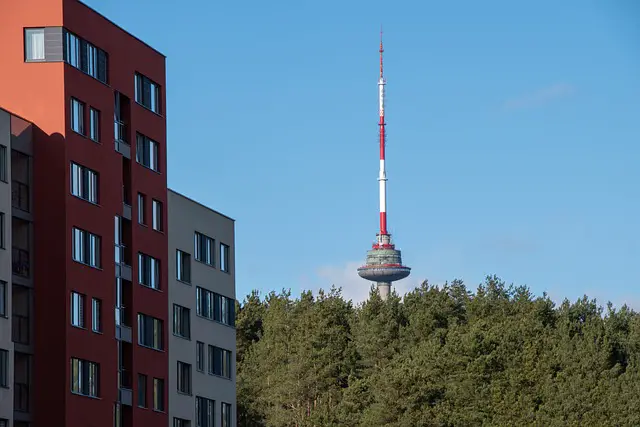
Tallest structure in Lithuania and a TV broadcasting tower.
What to see or do: Enjoy panoramic views of Vilnius from the observation deck located at a height of 165 meters.
Don’t miss: The restaurant and bar located on the observation deck offering a unique dining experience with stunning vistas of the city.
Insider travel tips: Opt for a visit during sunset to witness Vilnius transform into a beautiful city of lights. Pre-book your tickets to avoid long queues and take the elevator to reach the top quickly.
30. Biržai Castle

Medieval castle located in the town of Biržai, Lithuania.
What to see or do: Admire the intricate brickwork and architectural features of the castle’s towers, walls, and gateways. Take a tour of the castle’s interior to see historical artifacts and learn about the castle’s history.
Don’t miss: Walking around the castle’s extensive grounds, including the nearby Lake Širvėna. Taking a stroll through the castle’s underground tunnels.
Insider travel tips: Visit during the summer months to see the castle’s outdoor theater performances. Stop by the nearby Biržai Regional Park to experience the natural beauty of the surrounding area.
💪 Support independent web, support us: